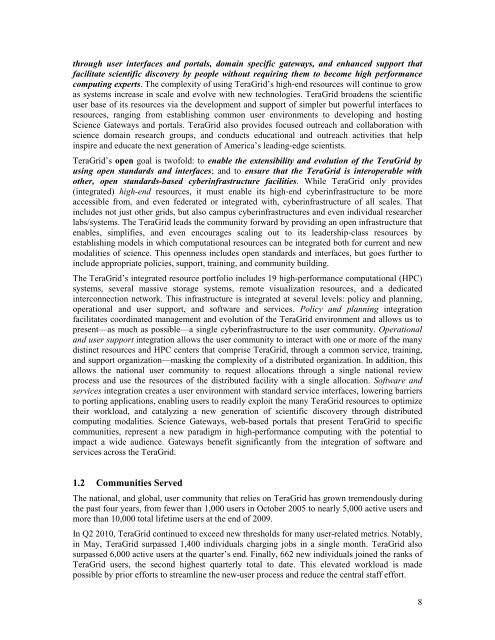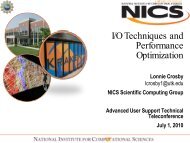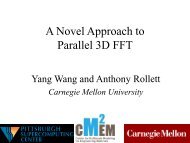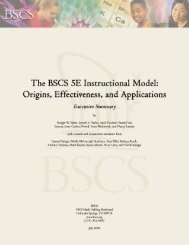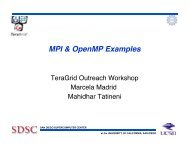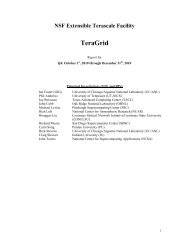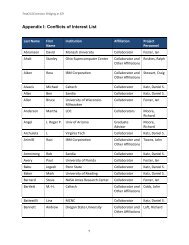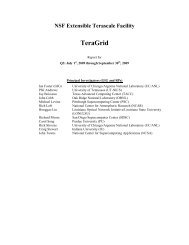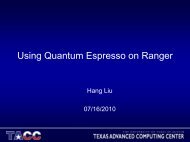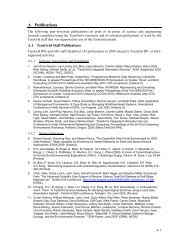TGQR 2010Q2 Report.pdf - Teragridforum.org
TGQR 2010Q2 Report.pdf - Teragridforum.org
TGQR 2010Q2 Report.pdf - Teragridforum.org
You also want an ePaper? Increase the reach of your titles
YUMPU automatically turns print PDFs into web optimized ePapers that Google loves.
through user interfaces and portals, domain specific gateways, and enhanced support that<br />
facilitate scientific discovery by people without requiring them to become high performance<br />
computing experts. The complexity of using TeraGrid’s high-end resources will continue to grow<br />
as systems increase in scale and evolve with new technologies. TeraGrid broadens the scientific<br />
user base of its resources via the development and support of simpler but powerful interfaces to<br />
resources, ranging from establishing common user environments to developing and hosting<br />
Science Gateways and portals. TeraGrid also provides focused outreach and collaboration with<br />
science domain research groups, and conducts educational and outreach activities that help<br />
inspire and educate the next generation of America’s leading-edge scientists.<br />
TeraGrid’s open goal is twofold: to enable the extensibility and evolution of the TeraGrid by<br />
using open standards and interfaces; and to ensure that the TeraGrid is interoperable with<br />
other, open standards-based cyberinfrastructure facilities. While TeraGrid only provides<br />
(integrated) high-end resources, it must enable its high-end cyberinfrastructure to be more<br />
accessible from, and even federated or integrated with, cyberinfrastructure of all scales. That<br />
includes not just other grids, but also campus cyberinfrastructures and even individual researcher<br />
labs/systems. The TeraGrid leads the community forward by providing an open infrastructure that<br />
enables, simplifies, and even encourages scaling out to its leadership-class resources by<br />
establishing models in which computational resources can be integrated both for current and new<br />
modalities of science. This openness includes open standards and interfaces, but goes further to<br />
include appropriate policies, support, training, and community building.<br />
The TeraGrid’s integrated resource portfolio includes 19 high-performance computational (HPC)<br />
systems, several massive storage systems, remote visualization resources, and a dedicated<br />
interconnection network. This infrastructure is integrated at several levels: policy and planning,<br />
operational and user support, and software and services. Policy and planning integration<br />
facilitates coordinated management and evolution of the TeraGrid environment and allows us to<br />
present—as much as possible—a single cyberinfrastructure to the user community. Operational<br />
and user support integration allows the user community to interact with one or more of the many<br />
distinct resources and HPC centers that comprise TeraGrid, through a common service, training,<br />
and support <strong>org</strong>anization—masking the complexity of a distributed <strong>org</strong>anization. In addition, this<br />
allows the national user community to request allocations through a single national review<br />
process and use the resources of the distributed facility with a single allocation. Software and<br />
services integration creates a user environment with standard service interfaces, lowering barriers<br />
to porting applications, enabling users to readily exploit the many TeraGrid resources to optimize<br />
their workload, and catalyzing a new generation of scientific discovery through distributed<br />
computing modalities. Science Gateways, web-based portals that present TeraGrid to specific<br />
communities, represent a new paradigm in high-performance computing with the potential to<br />
impact a wide audience. Gateways benefit significantly from the integration of software and<br />
services across the TeraGrid.<br />
1.2 Communities Served<br />
The national, and global, user community that relies on TeraGrid has grown tremendously during<br />
the past four years, from fewer than 1,000 users in October 2005 to nearly 5,000 active users and<br />
more than 10,000 total lifetime users at the end of 2009.<br />
In Q2 2010, TeraGrid continued to exceed new thresholds for many user-related metrics. Notably,<br />
in May, TeraGrid surpassed 1,400 individuals charging jobs in a single month. TeraGrid also<br />
surpassed 6,000 active users at the quarter’s end. Finally, 662 new individuals joined the ranks of<br />
TeraGrid users, the second highest quarterly total to date. This elevated workload is made<br />
possible by prior efforts to streamline the new-user process and reduce the central staff effort.<br />
8


